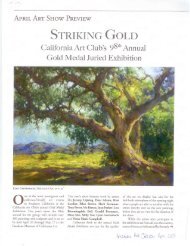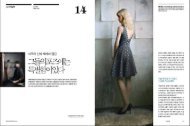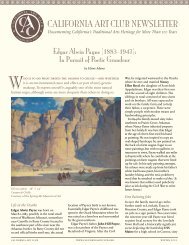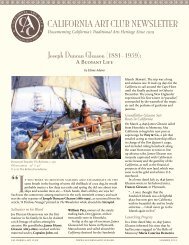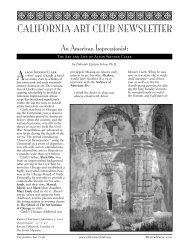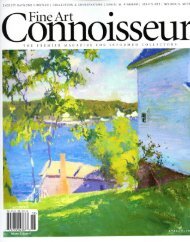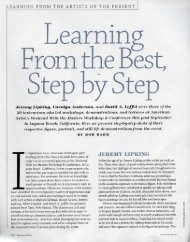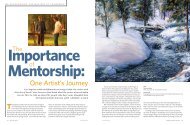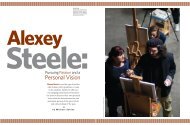(1876-1949) – An American Impressionist, by Deborah Epstein Solon
(1876-1949) – An American Impressionist, by Deborah Epstein Solon
(1876-1949) – An American Impressionist, by Deborah Epstein Solon
You also want an ePaper? Increase the reach of your titles
YUMPU automatically turns print PDFs into web optimized ePapers that Google loves.
8<br />
The Artist’s Cottage (Pasadena), c. 1925<br />
Oil on canvas 36 46<br />
Collection of Gregory A. Young<br />
shipping its contents to California.<br />
During the next several years<br />
Clark took frequent trips throughout<br />
California, the Southwest, and<br />
especially to Mexico, in particular<br />
Cuernavaca and Taxco where the<br />
architecture, landscape, and indigenous<br />
population inspired another<br />
aspect of his art. In 1925 Clark<br />
began a rather unlikely phase of<br />
his career as a mural painter when<br />
he was commissioned to paint the<br />
enormous curtain (measuring<br />
twenty <strong>by</strong> thirty-two feet) for the<br />
newly constructed Pasadena Playhouse.<br />
On the heels of its success,<br />
he was approached <strong>by</strong> J. Harvey<br />
McCarthy, a native Californian<br />
and wealthy entrepreneur who was<br />
financing the Carthay Circle Theater<br />
in Los <strong>An</strong>gles, to paint a series<br />
of murals chronicling the history of<br />
California. Clark settled on seven<br />
ambitious scenes, including The<br />
Arrival of the Oregon at San Francisco<br />
(c. 1925<strong>–</strong>26), documenting<br />
the arrival of the vessel that<br />
brought first official news of Cali-<br />
fornia’s statehood. Shortly thereafter<br />
he painted a series of murals<br />
at the Pasadena First Trust and<br />
Savings Bank (now Bank of the<br />
West), and eight large paintings for<br />
a private men’s club in Los <strong>An</strong>geles.<br />
Between projects, Clark continued<br />
to paint en plein air in the late<br />
1920s, mounting successful exhibitions<br />
with private dealers and<br />
museums throughout the country.<br />
Clark’s willingness to immerse<br />
himself in international cultures was<br />
a consistent element throughout his<br />
diverse career. With this understanding,<br />
his emerging characterization as<br />
a “California artist,” starting in the<br />
mid-1920s, seems incongruous.<br />
While Clark spent the latter portion<br />
of his career in California, over half<br />
of his life was spent elsewhere. Beginning<br />
in 1923, <strong>An</strong>tony <strong>An</strong>derson, critic<br />
for the Los <strong>An</strong>geles Times, began to<br />
shape Clark’s transformation:<br />
All globe-trotting artists land<br />
at some time in Southern California,<br />
and not a few of them<br />
unfurl their tents and decide<br />
to remain here forever and a<br />
day. It seems to be actually<br />
true—therefore—what we<br />
have seen and heard so often<br />
stated in print and out—that<br />
Southern California is the<br />
Mecca of painters. For many<br />
years Alson Clark has been a<br />
pilgrim and a wayfarer…. But<br />
he hadn’t found Mecca. Four<br />
years ago he came to Southern<br />
California and remained.<br />
By the early 1930s, Clark was<br />
accepting decorative commissions<br />
for private homes, designing<br />
wallpaper and screens, and painting<br />
murals for dining rooms and<br />
libraries. Although his interests<br />
were always diverse, he was<br />
undoubtedly delighted to find work<br />
during the depths of the Depression.<br />
However, against the bleak<br />
economic backdrop, Clark took a<br />
bold step in 1933: he decided to<br />
drive across the country with his<br />
family, allowing more than a year<br />
to meander and paint. In 1935 the<br />
couple took their final journey to<br />
Europe. Even after such a long hiatus,<br />
Clark still saw Paris through<br />
the same inquisitive eyes of his<br />
youth, painting city scenes such as<br />
Paris, Rooftops (1936) from their<br />
hotel window.<br />
Clark’s popularity<br />
remained consistent throughout<br />
the 1930s. While the battle raged<br />
between modern and traditional<br />
artists, Clark remained unaffected<br />
<strong>by</strong> the debate. He was a devotee of<br />
Impressionism throughout his life,<br />
patently rejecting modernism with<br />
no misgivings. Two generations of<br />
collectors had avidly acquired his<br />
works; his paintings continued to<br />
be included in museum and gallery<br />
exhibitions; and, in 1940, the Los<br />
<strong>An</strong>geles County Museum awarded<br />
him a self-curated retrospective of<br />
twenty paintings, including works<br />
California Art Club www.californiaartclub.org Winter/Spring 2006



